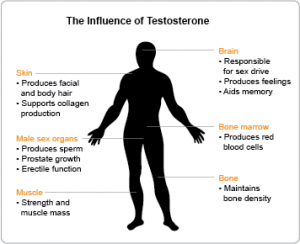Treating Testosterone Deficiency in Australian Pharmacy
TREATING TESTOSTERONE DEFICIENCY
Treatment of testosterone deficiency requires a unique three-component strategy in order to be successful. If this treatment strategy isn’t followed, not only will testosterone levels not be optimized, serious and potentially permanent side effects may result. Unfortunately, many well-meaning conventional physicians who have begun treating Andropause patients are not aware of the absolute requirement for this treatment strategy and are therefore unknowingly causing their patients problems, some of which may become irreversible. These three components of Andropause treatment are: 
- Testosterone Replacement Therapy: See discussion below
- Gonadotropin: Gonadotropins are hormones that stimulate growth and activity of the gonads. The gonads in males are the testicles (testes); female gonads are the ovaries. Gonadotropin replacement is required in Andropause treatment because of the body’s Hormonal Negative Feedback System. Composed of the gonads and the pituitary gland located in the brain, this feedback system is designed to keep the sex hormones in balance. When the pituitary, which has become accustomed to low testosterone levels (testosterone deficiency, Low T), suddenly senses the dramatic rise in testosterone caused by testosterone replacement, it believes that the testicles have miraculously overcome their previous problems and begun making up for lost time by producing high levels of testosterone.The pituitary then signals the testes to reduce testosterone production in order to prevent testosterone excess. This normal physiologic response cannot be allowed to happen for two reasons: the first reason is that negative feedback from the pituitary will result in the testicles producing even less testosterone than before, resulting in a worsening of the hormone deficiency state. That production, therefore, must be maintained at all costs. The second reason is even more important. Testicles receiving signals to reduce testosterone production over a sustained period of time essentially slip into a dormant state, causing them to atrophy (shrink up to nothing). And eventually become unable to produce testosterone — a condition that can be permanent.
- If permanent, the man is infertile and will require lifelong testosterone replacement. Most of you have heard the jokes about steroid-abusing bodybuilders ending up as great big boys with little bitty balls. Those jokes exist for a reason, because many of these athletes secured these drugs illegally on the black market and did not know how to use them properly. This misuse resulted in many of them becoming infertile and needing to take testosterone therapy for the rest of their life because they destroyed their body’s ability to make testosterone. This sad tale reminds us that testicles must be viewed like any other organ or muscle in the body. Muscles that are exercised regularly stay healthy and grow big and strong; conversely, muscles that are ignored or not exercised regularly wither away and become useless. “Use ‘em or lose ’em” is the operative phrase as regards testicles and testosterone production.
- The medications (gonadotropins) commonly prescribed to prevent the pituitary from turning off testosterone production are human chorionic Gonadropin (hCG), this comes as either an injection drops placed under the tongue (sublingual); and Clomiphene (brand name Clomid), which comes in pill form.